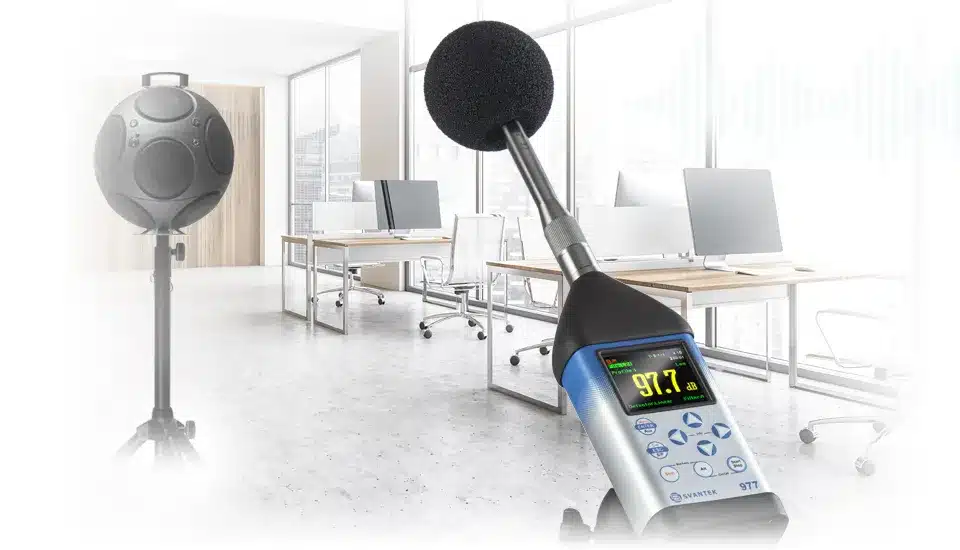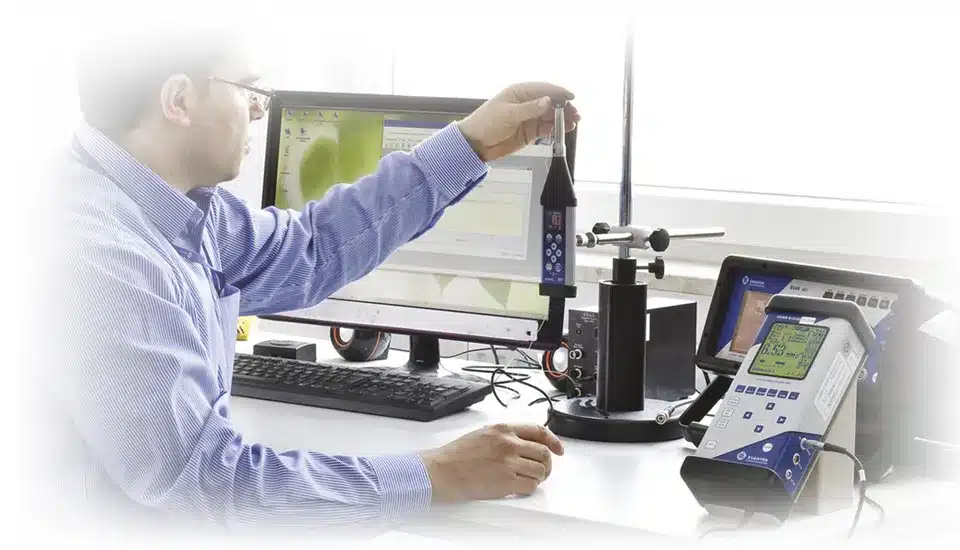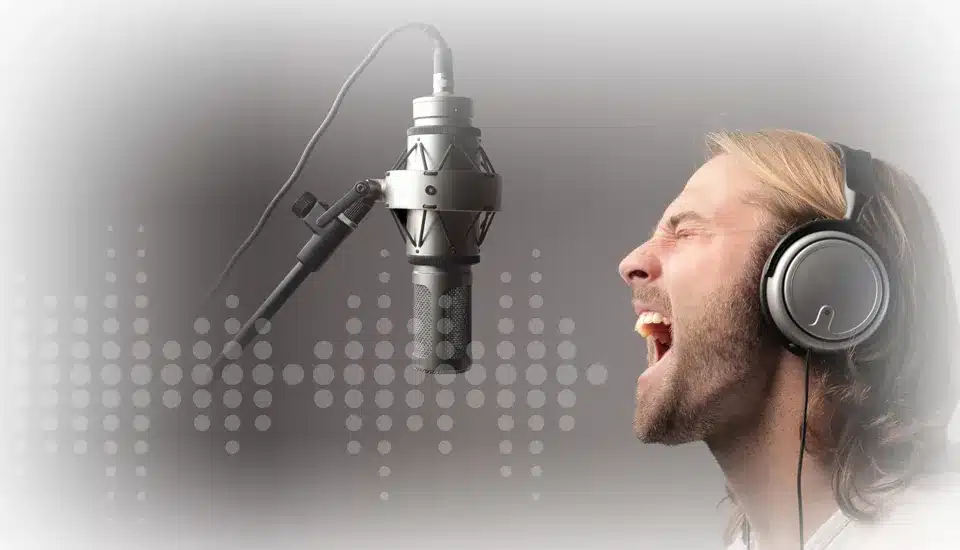What should you know about acoustics?
By definition, acoustics is a “branch of physics and technology” that deals with audible phenomena arising from the propagation of waves in space. Initially, the range of acoustics concerned only waves propagating in the air. Currently, it is much broader and also covers inaudible phenomena such as infra or ultrasound or vibrations that affect the human body and buildings.
Acoustics includes measurements at workplaces and in the environment, creating acoustic maps of cities, but also the very extensive topic of measuring vibrations. Not only audible sounds can have unpleasant consequences for our health. Acoustics also deals with the analysis of vibrations in the environment. This applies primarily to the protection of the health of people who are exposed to vibrations in their working environment, but also to the protection of buildings and acoustic comfort in rooms. The waves that propagate in the centers may be pleasant, like music, or unwelcome to us.


The most comprehensive acoustics studies in Poland are offered by the AGH University of Science and Technology in Kraków. There you can get an engineer and master’s degree in Acoustic Engineering. You can also study acoustics at the University of Adam Mickiewicz in Poznań. Postgraduate studies on noise can also be started at the Warsaw University of Technology.
By definition, “noise” is “loud and disturbing sounds.” These are sounds that we consider unwanted. Production halls, highways, music clubs, planes, trains, and industrial machines are just some of the many possible sources of noise in the environment. When new production halls are built, new roads or airport connections, the consequences of the growing noise level in cities must be taken into account. Along with the noise level in cities, people’s awareness of acoustics is also growing. When noise becomes a nuisance to our everyday lives, we look for effective solutions. The consequences of long-term exposure to noise and vibrations are hearing problems, sleep disorders, irritability, and the so-called vibration syndrome.

The first type of noise is acoustic noise. Such noise is all that we hear and what is bothersome for us. These are mainly airborne sounds, i.e. sounds transmitted through the air. This kind of noise is most damaging to our auditory system. Acoustic noise measurements can be made using a sound level meter with a microphone.

The second type of noise is vibration noise. Vibrations can damage the structure of buildings. In the case of vibrations affecting humans, we feel it in different ways. We can hear it but also feel it when touching a given surface or being in a vibrating structure. The effects of excessive exposure to this noise are, among others, vibration disease, and problems with the circulatory system, or the nervous system. To measure vibration noise, we use noise meters and vibration transducers attached to them.
The noise level is measured using sound level meters or vibration meters. Acoustic noise measurements consist of determining the values of acoustic parameters or indicators with a specific uncertainty. In the case of measurements of the acoustic parameters of rooms, these are primarily the insulation of walls and ceilings, reverberation time, and speech intelligibility for buildings such as theaters or operas.
The most frequently measured parameter is LAeq. It is the equivalent sound level determined with the A characteristic. For environmental noise measurements, parameters strictly defined by law are determined, such as long-term A-sound level for specific times of the day, night, and evening or day/night time. Appropriate reports or reports are prepared for the performed measurements.

Acoustics in the environment is controlled by an environmental protection law. Thanks to these regulations, it is possible to combat noise in cities and provide acoustic comfort to residents. Usually, the requirements of the environmental protection law are implemented by national Environmental Protection Agencies (EPA). This inspection performs scheduled activities once a year and unplanned activities in connection with applications that may come from the requests of public administration bodies. Examples of noise measurements for the benefit of the EPA are environmental noise from traffic and industrial noise.
Noise generated by installations should be monitored continuously or on a regular basis. In the case of industrial noise, the acoustic power of devices is most often measured. Industrial noise is dangerous in the context of the environment but also poses a great danger to people who operate machines that are noisy.


Vibrations generated by machines and devices can be used for the diagnostics of these machines. Using knowledge of the appropriate parameters of these vibrations, it is possible to determine the technical condition. Efficient devices usually generate less noise than damaged ones. By changing the noise generated by the machine, we can diagnose damaged elements and introduce appropriate changes.
The values of the operating thresholds for vibrations and noise at the workplace are defined by local regulations. In Poland (following EU regulations), the noise at work threshold is 80 dB – this is the noise exposure level related to 8 hours of working time or related to the working week. For hand-arm vibrations the limit is 2.5 m/s2 and 0.5 m/s2 for whole-body vibrations. If an employee is exposed to noise and vibrations at his workplace, the employer is obliged to monitor whether the permissible values are not exceeded. People exposed to noise and vibrations can then claim compensation or changes to the workplace.


When analyzing workplaces, it is also worth considering the increasingly popular open-space offices. While the noise in such offices usually meets the requirements of the regulation, interference from other positions severely affects the intelligibility of speech. The most popular solutions to the noise problem in open-plan spaces are sound-absorbing ceilings and acoustic panels that form partitions between workstations.
The main components of environmental noise are traffic routes. The concept of “traffic routes” can be understood as the noise generated by the passage of trains, trams, and cars; flights, landings, and take-offs; and movements in water ports. As a result of these phenomena, a very large amount of energy is generated, which we understand as audible noise. At the same time, vibrations are also generated, which can damage the structure of buildings. Acoustic screens are very often used to isolate sounds from, for example, highways or expressways.

Acoustic barriers are used as an artificial or natural obstacles to noise from traffic routes. The barriers isolate built-up and residential spaces from a noisy road, and can also reflect sound. An acoustic shadow area is created behind the barrier, which is characterized by reduced noise.
The use of natural acoustic barriers is very popular. These are barriers using rows of trees growing along communication routes, forests, or natural earth embankments. Acoustic barriers are a very effective tool to combat excessive noise resulting from vehicle passes.


By analyzing the sound in the environment, a section of acoustics called eco-acoustics was also distinguished. It is a section covering issues related to the use of sound in the seas, oceans, and in the natural environment. Eco-acousticians study the effects of noise on wildlife, the role of sound in the natural environment, and create soundscapes in cities.
The noise from traffic routes can become a great threat to buildings in the vicinity. Construction and renovation also pose such a threat. In order to be able to assess such an impact, it is necessary to measure the values of vibrations transmitted to buildings. Usually measured harmful vibrations are in the range of up to 100 Hz.
As for residential buildings, the insulation of partition walls and ceilings is also normatively defined. New technologies in construction allow for the lighter construction of buildings. Unfortunately, this makes the walls much more transparent to the sound. In response to these changes, a construction law was created that defined minimum insulation values for walls, doors, and windows. This obliges developers to control these parameters and thus to meet at least the lowest guidelines defined by this law. In addition to the construction design, it is necessary to control the acoustic insulation against airborne and impact sounds. However, the normative indicators do not take into account the individual perception of sound people. Psychoacoustics deals with the analysis of this.

Sounds can be perceived by each person differently. By definition, psychoacoustics is “a branch of science dealing with the study and description of the relationship between a sound wave reaching the listener’s ears and the subjective sensation it produces.” Thus, the sounds we hear may be pleasant for some and irritating to others.
Acoustics has also found a very wide application in the field of medicine. On the basis of measurements of laryngeal vibrations, it is possible to diagnose diseases related to the voice organ. Thanks to acoustics, we can also carry out ultrasound examinations. The operation of an ultrasound scanner is based on the emission and reception of an ultrasound wave. Acoustics is also used in the diagnosis of lung diseases and cardiovascular diseases.

Another branch of acoustics is electroacoustics. It is a combination of electronics and acoustics. By definition, we refer to electroacoustics as “the field of science and technology dealing with issues related to the processing of acoustic vibrations into electrical signals and vice versa”. Such sound processing is possible with the use of microphones and vibration transducers. Additionally, it also includes the processes of recording, playing, and transmitting sounds.


When considering acoustic topics, one should not forget about the very extensive field of recording, playback, and sound amplification. Acoustic measurements are carried out mainly at the stage of creating recording studios, theaters, and operas. Acoustic measurements are also performed for the purposes of tuning the public address system before concerts.
The acoustic analysis is also important at the stage of preparing the stage for the concert. Proper placement of a stage in space or a sound reinforcement system often requires considering the environmental conditions or taking appropriate measurements. A conscious approach to the organization of concerts in the context of sound allows for comfort and pleasant experiences for the participants of the event.
At a very early stage, the right acoustics are designed in sound recording studios. Good acoustic parameters allow you to control the sound that will be recorded or played in a given room. In addition to good acoustics, it is also necessary to work properly with the microphone. Acoustics today is not only used for professional applications. Architects are increasingly using the services of acoustics when designing interiors.
First of all, when designing the interior, you should analyze the appropriate arrangement of the rooms. Rooms such as bathrooms should be properly acoustically separated from other parts of the house. Thanks to acoustics, it is possible to reduce the noise level generated by ventilation, water flow, or radiators. By using appropriate acoustic systems, it is also possible to reduce the reverberation time. This is especially important in rooms with large cubic volumes.
Acoustic systems are very well suited to controlling acoustics inside rooms. Thanks to the appropriate panels, it is possible to reduce the reverberation time in a room or reduce the noise level. We can also isolate the noisy device in the room in this way. Acoustic panels give us the opportunity to change the acoustics inside the room without major interference with the building structure.